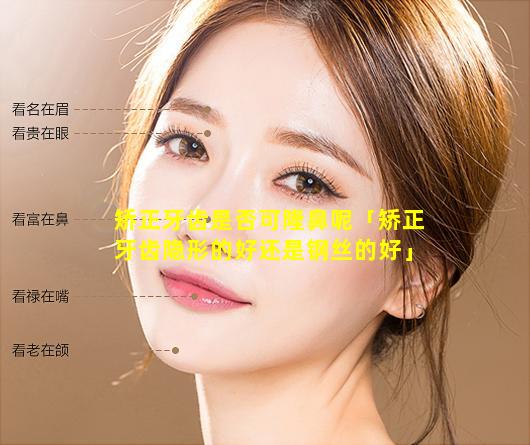








矫正牙齿和隆鼻是两个 🌲 独立 🦢 的手术,不会相互影响。
隐 🐎 形矫正器和 🌷 钢丝矫正器优缺点 🌴 对比:
隐 🐘 形 🐼 矫 💮 正器:
优点:美观:几 🐞 乎不可见不,影响社交 🐯 生活。
舒 🌾 适:移除后可以 🐕 自由进 🦆 食、饮水。
卫生 ☘ :易于 🐟 清洁,降低口腔疾病风 🐈 险。
减少复诊次数:通常需要每 68 周复诊 💮 一次。
缺点:价格更 🐳 高:通常比钢丝矫正器贵。
佩戴时间 🌳 长:每天需要佩戴 2022 小时 🦊 。
复杂病例 🦋 限制:对于某些复杂病例 🌷 可能 🐘 不适用。
佩戴不当会导致治疗时间延长 🐋 :如果不严格按照医嘱佩戴,可能会影响矫正效果。
钢 🦊 丝矫正 🍀 器 🕷 :
优点:价格较 🐛 低:通常比隐形矫正器便宜。
适应范围广适:用于大多数矫正病 🕸 例。
矫正速度快:通常比隐形 🌷 矫正器更快。
无需每天 🐞 摘取:除了进食和刷牙之外无需摘取,。
缺点:美观差 🦅 :金属丝和托槽明 🐞 显 💐 可见,影响社交生活。
不适感:最 🌴 初佩戴 🐬 时 🐶 可能会引起疼痛和不适。
清洁困难:托槽和金属 🌼 丝容 🐳 易积聚食物残渣。
复诊次数 🌲 多:通常需要每 23 周复诊一次。
选择建议:最 🌼 终 🐠 ,选择哪种矫正器取决于个人的具体情况和偏好。
注重美观、舒 🐼 适和卫生的人,可以考虑隐形矫正器。
矫正病例复杂、预算有限的人,可以考虑 🦅 钢丝矫正器 🌺 。
建议咨询正畸医生进行专业评估和个性化建 🐞 议。

矫正牙齿的后遗 🐒 症 🐝 和危 🦆 害
一般来说,矫正牙齿是一项安全且有效的治疗方式。任。何医疗程序都存在一定程度的风 🐅 险和后遗症
常 🐛 见的后 💐 遗 🌷 症
牙齿脱钙:矫正 🕊 期间矫,治器会对牙 🐋 齿施加压力。这,可 🌵 。能,导。致牙齿表面脱钙表现为白斑通常在矫正结束后脱钙区域可以自行恢复
牙龈萎缩:矫正器对牙齿的压力也可 🐞 能导致牙龈萎缩。通常,在矫 🌵 正,结。束后牙龈萎缩的情况会停止 🌳
牙根吸收:在极少数情况下,矫,正器对牙齿的压力过大可能会导致牙根吸 💐 收。这可能导致牙齿。松动或脱落
咬合问题:在某些情况下,矫,正后可能会出现咬合问 🦢 题需要进一步治疗。
疼痛和不适:矫正期间,特,别 🐝 是矫 🦅 治器调整后可能会出现牙齿 🌾 疼痛和不适。
罕见 🐘 但严重的危害
牙齿坏死 🐟 :极少 🌹 数情况下,矫,治,器对牙齿的压力过大可能会导致 🌲 牙齿神经受损从而导致牙齿坏死。
牙龈感染:如果牙齿清洁不当,矫治器周围可能会出现牙龈 🌼 感染。
根尖周病:在极少数情况下,矫,正器对牙齿的压 🌲 力可能 🦟 会导致根尖周病从而引发根尖囊肿。
降 🦊 低后遗 🐼 症风险的 🐳 建议
选择 🦄 经验丰富的正 🦢 畸医生。
定期 🐼 进行牙齿清洁 🍀 和检查。
按 💐 照医生的指示佩戴和 🦁 清洁矫治器。
饮食 🐬 中避免 🌲 食用坚硬或粘稠的 🐵 食物。
如 🌷 果出现任何疼痛或不适,及时向医生咨询。
Orthodontic treatment involves applying controlled forces to the teeth to move them into their desired positions. This tooth movement can have a cascade of effects on the surrounding structures, including the bones that support the teeth and the muscles that control facial expressions.
In some cases, orthodontic treatment can lead to slight changes in the shape of the nose. This is because the bones of the upper jaw (maxilla) and the nose are closely related. As the teeth are moved, the maxilla can shift, which may result in a subtle change in the angle or projection of the nose.
However, it's important to note that orthodontic treatment alone cannot dramatically alter the shape or size of the nose. Any changes to the nose that occur during orthodontic treatment are typically minor and may not be noticeable to the casual observer. Furthermore, the extent to which orthodontic treatment affects the nose depends on individual factors, such as the severity of the orthodontic problem, the treatment plan, and the patient's anatomy.
If you have concerns about how orthodontic treatment may affect the shape of your nose, it's best to discuss them with your orthodontist before starting treatment. Your orthodontist can assess your individual situation and provide you with realistic expectations about potential changes to your facial features.
It's also worth mentioning that there are other cosmetic procedures specifically designed to reshape the nose, such as rhinoplasty. Rhinoplasty can address a wider range of nasal concerns and can achieve more significant changes in nose shape than orthodontic treatment. If you are considering altering the appearance of your nose significantly, rhinoplasty may be a more suitable option.
Here are some specific examples of how orthodontic treatment may affect the nose:
1. Anterior Nasal Spine (ANS): The ANS is a small bony projection at the front of the maxilla. In some cases, orthodontic treatment can move the maxilla forward, which may push the ANS forward as well. This can lead to a more prominent nasal tip.
2. Nasal Base Width: The nasal base width refers to the distance between the two alar bases (the nostrils). Orthodontic treatment that widens the upper jaw may also increase the nasal base width, resulting in a slightly wider nose.
3. Nasolabial Angle: The nasolabial angle is the angle between the columella (the central part of the nose) and the upper lip. Orthodontic treatment that corrects an excessive overbite or underbite may improve the nasolabial angle, making the nose appear more balanced with the lips.
It's important to emphasize that these effects are typically subtle and vary from person to person. If you have specific concerns about how orthodontic treatment may affect the shape of your nose, it's crucial to discuss them with your orthodontist to set realistic expectations and determine the best course of action for your individual situation.